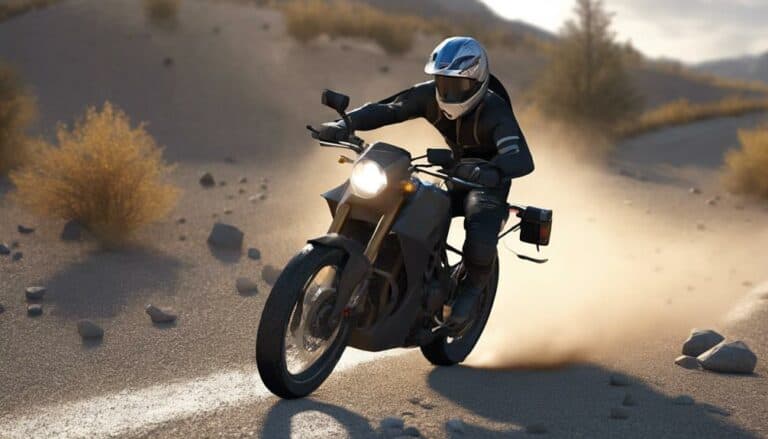When negotiating corners on diverse off-road terrains like gravel, mud, or sand, your approach requires nuanced adjustments to conquer each surface effectively.
The challenge lies in mastering the art of cornering by adapting your speed, line selection, and body positioning to match the specific demands of the terrain.
By understanding how to tailor your technique for gravel's loose grip, mud's slick conditions, or sand's shifting nature, you can enhance your off-road riding skills and tackle corners with confidence.
Key Takeaways
- Adjust speed and technique based on surface characteristics for optimal traction
- Lean bike into turns for better stability and traction on gravel, mud, and sand
- Use wider tires with lower pressure and maintain momentum in sandy conditions
- Practice on various surfaces to develop skills and adapt cornering approach
Cornering Techniques on Gravel
When riding gravel corners on your bike, maintaining a moderate speed and avoiding sudden movements is crucial to prevent loss of traction and ensure stability. The loose nature of gravel can easily cause your bike's rear wheel to slip out if you accelerate or brake abruptly. To maintain grip, lean your bike slightly into the turn, allowing the tires to dig into the gravel for better traction. Focus on smooth weight shifts by keeping your body relaxed and adjusting your center of gravity to adapt to the ever-changing surface.
As you approach gravel corners, plan your line carefully to follow the path with the best traction. Use countersteering techniques to initiate the lean and maintain control throughout the corner. Remember to avoid excessive front brake usage, as this can lead to the front wheel washing out on the loose gravel. By mastering these cornering techniques for gravel riding, you'll enhance your overall riding skills and feel more confident tackling challenging off-road surfaces.
Adapting to Mud Cornering Challenges
Handling mud corners poses unique challenges that require precise technique and adaptability to maintain control and traction. When maneuvering muddy corners, remember these key tips:
- Wider Line and Lower Speed: Mud demands a wider cornering line and reduced speed to enhance stability and traction.
- Bike Lean vs. Body Lean: Lean the bike more than your body in mud to prevent sliding and maintain control.
- Feather the Brakes: Lightly feather the brakes to prevent skidding, ensuring you maintain momentum through muddy corners.
- Shift Weight Back: Shifting weight towards the rear of the bike helps prevent front wheel washouts, sustaining steering control in muddy conditions.
Mastering Sand Cornering Skills
Sand corners require a different set of skills compared to mud, emphasizing maintaining momentum and utilizing proper body positioning for smooth handling. When riding on sand, it's vital to keep your momentum up to prevent sinking.
Lean your bike into the turn and steer using your hips to navigate sandy corners smoothly. Using wider tires with lower pressure can provide better traction and floatation in sand, helping you maintain control through the corners.
Practice riding in sandy conditions to develop a feel for the unique handling and cornering techniques required. Avoid sudden movements and maintain a relaxed grip on the handlebars to stay in control on the loose surface.
Cornering Strategies for Different Surfaces
For best control and traction on different surfaces, mastering cornering strategies is essential. When steering off-road terrains like gravel roads, mud, or sand, adapting your cornering approach is critical. Here are some tips to help you tackle corners effectively on various surfaces:
- Gravel Roads: Lean the bike into the turn while keeping your body upright. This position enhances stability and traction on the loose surface.
- Mud: Anticipate sliding and adjust your body position accordingly. Maintaining balance through the corner is key to controlling the bike in muddy conditions.
- Sand: Keep up your momentum and avoid sudden changes in direction to prevent sinking. Consistent speed and gradual movements will help you handle sandy corners smoothly.
- Cornering Speed: Adjust your speed and technique based on the specific off-road surface. Maximizing traction while minimizing sliding requires adjusting your approach to suit the handling characteristics of each terrain.
Practice cornering on different surfaces to develop a feel for their unique handling traits and improve your overall off-road riding skills.
Off-Road Cornering Adjustments
When exploring off-road terrain, adapting your cornering technique is essential for maintaining control and traction on varying surfaces.
On a gravel road, take a wider line through corners to find better traction and avoid loose patches that can cause instability.
In mud, reduce your speed before entering corners, apply gentle inputs, and keep a light touch on the controls to prevent sliding.
When cornering on sand, lean the bike more than usual to create a stable platform and make sure you maintain momentum through the turn.
Adjust your cornering speed in mud and sand, as these surfaces require slower entry and exit speeds to maintain control.
Feather the brakes lightly on loose surfaces like gravel and sand to help you maintain stability while cornering.
Conclusion
Just as a skilled artist adapts their brush strokes to different canvases, a rider must adjust their cornering technique to varied off-road surfaces.
By mastering the art of leaning on gravel, staying upright on sand, and handling mud with finesse, you can paint a masterpiece of control and stability through every turn.
Remember, the off-road terrain is your canvas, and your bike is the brush – embrace the challenge and ride with confidence.

